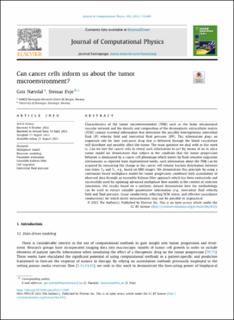| dc.contributor.author | Nævdal, Geir | |
| dc.contributor.author | Evje, Steinar | |
| dc.date.accessioned | 2023-09-19T11:48:37Z | |
| dc.date.available | 2023-09-19T11:48:37Z | |
| dc.date.created | 2023-09-13T22:25:28Z | |
| dc.date.issued | 2023 | |
| dc.identifier.citation | Nævdal, G. & Evje, S. (2023) Can cancer cells inform us about the tumor microenvironment? Journal of Computational Physics, 492, 112449 | en_US |
| dc.identifier.issn | 0021-9991 | |
| dc.identifier.uri | https://hdl.handle.net/11250/3090431 | |
| dc.description.abstract | Characteristics of the tumor microenvironment (TME) such as the leaky intratumoral vascular network and the density and composition of the desmoplastic extracellular matrix (ECM) contain essential information that determine the possibly heterogeneous interstitial fluid (IF) velocity field and interstitial fluid pressure (IFP). This information plays an important role for how anticancer drug that is delivered through the blood vasculature will distribute and possibly affect the tumor. The main question we deal with in this work is: Can we lure the cancer cells to reveal such information to us? By means of an in silico tumor model we demonstrate that subject to the condition that the tumor progression behavior is dominated by a cancer cell phenotype which moves by fluid-sensitive migration mechanisms as reported from experimental works, such information about the TME can be acquired by measuring the change in the cancer cell volume fraction distribution between two times T0 and T1, e.g., based on MRI images. We demonstrate this principle by using a continuum based multiphase model for tumor progression combined with assimilation of observed data through an ensemble Kalman filter approach which has been extensively and successfully used for updating advanced multiphase flow models in the context of reservoir simulation. Our results based on a synthetic dataset demonstrate how the methodology can be used to extract valuable quantitative information (e.g., interstitial fluid velocity field and fluid pressure, tissue conductivity reflecting ECM status, and effective vasculature conductivity) for which direct measurements may not be possible or impractical. | en_US |
| dc.language.iso | eng | en_US |
| dc.publisher | Elsevier Ltd. | en_US |
| dc.rights | Navngivelse 4.0 Internasjonal | * |
| dc.rights.uri | http://creativecommons.org/licenses/by/4.0/deed.no | * |
| dc.subject | kreftceller | en_US |
| dc.subject | kreftsvulster | en_US |
| dc.title | Can cancer cells inform us about the tumor microenvironment? | en_US |
| dc.type | Peer reviewed | en_US |
| dc.type | Journal article | en_US |
| dc.description.version | publishedVersion | en_US |
| dc.rights.holder | © 2023 The Author(s). | en_US |
| dc.subject.nsi | VDP::Matematikk og Naturvitenskap: 400::Fysikk: 430 | en_US |
| dc.subject.nsi | VDP::Medisinske Fag: 700::Klinisk medisinske fag: 750::Onkologi: 762 | en_US |
| dc.source.volume | 492 | en_US |
| dc.source.journal | Journal of Computational Physics | en_US |
| dc.identifier.doi | 10.1016/j.jcp.2023.112449 | |
| dc.identifier.cristin | 2174887 | |
| dc.source.articlenumber | 112449 | en_US |
| cristin.ispublished | true | |
| cristin.fulltext | original | |
| cristin.qualitycode | 2 | |

